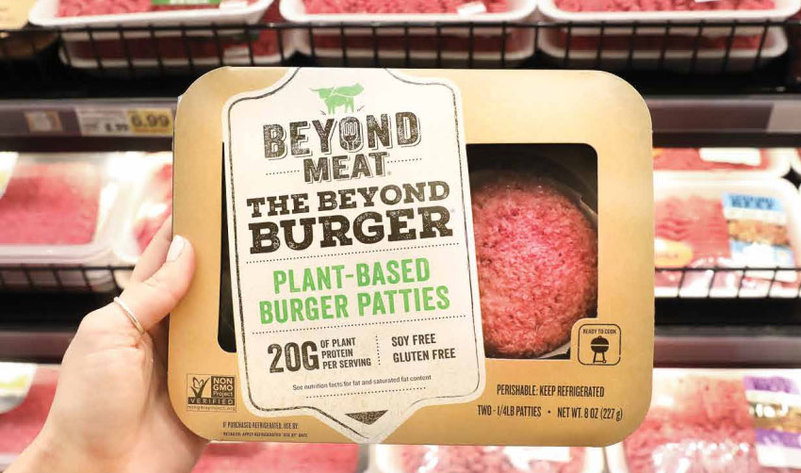Guidance on how to hit the food brand home run
Poised to create and capture the next wave in center-of-plate meal preferences, Beyond Meat is scaling at break-neck speed in both grocery and foodservice channels, throwing off sparks of insight to all emerging food brands who will listen about the new path to relevance and glory.
At Chicago’s recent Good Food Financing conference produced by the venerable Jim Slama of Family Farmed and Good Food Accelerator, keynote speaker Seth Goldman held the audience of embryonic food brand founders and equity investment executives in rapt attention while delivering a data driven highlights reel of business home run after home run. The score sheet demonstrated in dramatic fashion how Beyond Meat’s team is leading the nascent meatless meat invasion, while disrupting conventions and traditions of the legacy animal-based proteins industry.
 Within Goldman’s engaging recap of refrigerated beef patty without the beef, was a significant revelation to all of the strategic leaps Beyond Meat achieved. “Animals are really four-legged bio-processors of plant materials, converting the ingredients to meat,” he said. Thus, meat in truth actually comes from plants, and Beyond has amazingly reverse engineered the components of meat structure to imitate and recreate the same bite and flavor characteristics of the animal variety.
Within Goldman’s engaging recap of refrigerated beef patty without the beef, was a significant revelation to all of the strategic leaps Beyond Meat achieved. “Animals are really four-legged bio-processors of plant materials, converting the ingredients to meat,” he said. Thus, meat in truth actually comes from plants, and Beyond has amazingly reverse engineered the components of meat structure to imitate and recreate the same bite and flavor characteristics of the animal variety.
Said Goldman: “Our goal is to enable consumers to eat what they love.” Right there was respect for what consumers want, and a vault from making vegetarian meat for vegetarians to making plant-based meat for meat lovers. The foundations of this strategic narrative are critical and inform how the entire Beyond story unfolded. Within his story is a living example of what separates ‘just another one’ from a meaningful innovation that influences consumer behavior and informs the future of food.
It worked because this plant-based juggernaut fully delivered on its promise to replicate the animal meat taste and texture eating experience. “Traditional veggie burgers look to us like a plot by the meat industry to make sure plant-based versions aren’t a threat because, let’s face it, they don’t taste very good – and I’m a vegetarian,” Goldman reports.
Meanwhile the plant-based category table is set for dinner:
Trend lines seem clear that plant-based anything is on the way up, as consumers “flex” their preferences and look for what they believe are healthier alternatives that are friendlier to the environment but which also deliver fully on taste experiences consumers crave.
According to IPSOS, 54 percent of consumers say they’re trying to consume fewer animal-based foods and eat more plant-based options. What’s going on here? Shifting values mixed with health and wellness is what’s going on. SPIN Scan data reveals that refrigerated plant-based meat is up 37 percent year on year to $212 million in sales.
No surprise, it is outpacing animal meat sales. Within the $270 billion US meat category, plant-based share is under 1 percent. The upside is significant and bodes well for Beyond as first mover and brand perception leader in the space.
Mintel’s 2018 “Better for you Eating Trends” study provides evidence of why it’s best to strike when the macro trends are working in your favor. In their national survey, Mintel found across all four primary age segments, consumers said they agree with the following statements:
- Plant-based protein is healthy – yes for 74 to 80%
- Plant-based foods are better for the environment – yes for 47 to 63%
- Plant-based functional claims are trustworthy – yes for 35 to 56%
- Plant based foods are better for you than animal options – yes for 42 to 50%
Dollar sales for plant-based meat in the aggregate, frozen or fresh, is $801 million and rising rapidly.
By the way, this form of market-opportunity-assessment matters for the business plan!
Emergent Guidance on the Path to Victory
Surveying the adjacent exhibit hall of new, emerging food and beverage brands, Beyond stood as the “A” lister in a field of hopefuls who bare their heart and soul daily in product concepts that authentically align with higher quality, more artisanal and healthier food solutions now fueling the renaissance in Good Food. The acid test, however, is can they redefine the categories they’re playing in or will they plateau among a collection of similar offerings with similar stories and similar preparations.
The secrets to outsized success continue to follow six repeating themes:
- Think Differently Going In
It would have been logical and expected for Beyond – founded by Ethan Brown, a vegetarian – to exist in service of that ethos and segment, working to create a better product for this devoted marketplace. But the mental leap to create a product for meat lovers caused the entire R&D development process to rally around a specific standard of performance and outcome with a moonshot at a VERY big market. Vegetarians are roughly 5% of the population and have remained anchored at that level for some time.
The goal to build an analog to meat inspired the revolution unfolding before us.
- Disrupt the Space You’re Entering
Beyond Meat defied the conventions and expectations of its veg foundation, opting to swing for the meat department case fence. Beyond could have easily been a frozen product in the vegetarian section freezer case. Instead they pushed and cajoled retailers to merchandize their products alongside animal meat, and in doing so, not only accentuate the perception that this was a legit option to a beef product, but also meet the meat shoppers where they shop.
Entrepreneurs would be well advised to look for extreme disruption, major departures, unconventional solutions, big moves on the perception chess board that constitute uniqueness.
Legacy food brands often suffer from a recurring illness we refer to as line extension-itis. Read as, adjustments, incremental improvements to an existing idea that don’t ultimately reframe the category.
Relatively minor improvements to ingredient strategies, recipes, preparation techniques or story may not be enough to inspire the kind of attention and magic that leads to new category creation, the zenith of best-in-class marketing opportunity.
- Focus on Taste Satisfaction
Formulation can be a fickle friend. While hitting benchmarks on nutritional label improvements and better-for-you metrics, taste sometimes gets marginalized. I will never forget my first bite of a Beyond Burger at the Chicago Restaurant Show, in a backwater booth buried in the better for you zone, where curiosity got me up to the table. And then – Holy Cow – I swore it was a ‘burger burger,’ not a veggie burger. Relentless search of optimal marriage between culinary and taste considerations with healthier is paramount. Taste wins every time.
- Place the Right Bets
Most people believe that plant-based anything is healthier, but Beyond wisely did not elect to make nutritionals a predominant part of their go-to-market game plan. For the simple reason, that pound for pound a Beyond Burger isn’t necessarily a traditional nutrition label winner. Yes there’s no cholesterol, but…
Instead Beyond wisely pursued a values-based messaging platform weighed against the environmental tax exacted by raising animals who compete for natural resources. Beyond Meat tells us their product creation process (compared to animals) consumes or produces:
79% less water
93% less land
90% fewer greenhouse gases
46% less energy
- Tell Your Story, everywhere your customer or stakeholder can be found
If Seth isn’t a walking, talking personification of this point, I don’t know what is. Goldman the Ambassador of Beyond is everywhere, bringing the remarkable news of the company’s outsized performance to any and all who will listen.
These business and media audiences are chocked full of content creators and reporting types like me who turn around and do what I’m doing here.
We extol emerging brand companies — be careful not to short sheet the brand building process early on. Yes, cash is at a premium and yes, resources are limited, but the “if we build it they will come” mentality is a recipe for small ball. All marketing is strategic storytelling. You have to invest here and sooner rather than later.
It takes experienced hands to shape and inform the consumer-ready brand story efficiently and with great impact – thus, why Emergent exists. We’re good at this, but then again, we’ve been doing it to great effect across multiple categories and honed our communications techniques and strategies.
- Relentlessly Innovate
Goldman will tell you the Beyond Burger today is different, and better, than the Beyond product was when they first got traction. He claims the company has 70 scientists at their Manhattan Project campus in California, working around the clock to improve their taste, recipe and nutritionals – and to innovate new products like the recent Dunkin ‘Beyond Sausage Sandwich’ for the hand-held breakfast crowd. Don’t rest on your laurels, don’t stop working to make it better and to search for the next meaningful adjacency where the product concept can go to solve yet another problem or capture another market opportunity.
Be careful, however, to avoid extending your brand in areas too far afield of your core equity where the proposition dilutes rather than builds on what consumers believe is your expertise.
While the barriers to entry have fallen away for emerging food and beverage ideas, and yes everyone knows it won’t be easy, there are key ingredients in here that spell the difference from modest growth to something that looks like Beyond Meat.
Our Offer…
So we make this offer: let us come in and conduct an audit, no cost, of your current platform, product concept, supply chain, and business opportunities. We’ll provide an assessment and make some recommendations and if you agree, perhaps we can partner on a future path to business transformation.
You have nothing to lose and everything to gain. Let me know.
Looking for more food for thought? Subscribe to our blog.
Bob Wheatley is the CEO of Chicago-based Emergent, the healthy living agency. Emergent provides integrated brand strategy, communications and insight solutions to national food, beverage, home and lifestyle companies. Emergent’s unique and proprietary transformation and growth focus helps organizations navigate, engage and leverage consumers’ desire for higher quality, healthier product or service experiences that mirror their desire for higher quality lifestyles. For more information, contact [email protected] and follow on Twitter @BobWheatley.






